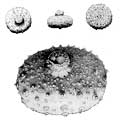The Echinoid Directory
Contributed by Andreas Kroh, August 2010
Hypsiechinus Mortensen, 1903, p. 81.
| Diagnostic Features |
|
|---|---|
| Distribution | Recent; North Atlantic (around Iceland). |
| Name gender | masculine |
| Type | Hypsiechinus coronatus Mortensen, 1903, by monotypy. |
| Species Included | Only the type. |
| Classification and/or Status | Camarodonta; Temnopleuroida;Trigonocidaridae. |
| Remarks | Differs from Trigonocidaris by its thorny spines, largely unsculptured corona and its distinct sexual dimorphism. Note that Mortensen placed this genus in the Trigonocidaridae. Mortensen, T. 1903. The Danish Ingolf-Expedition 1895-1896. Vol. 4, No. 2. Echinoidea, pt. 1, 198 pp., 21 pls. Bianco Luno, Copenhagen. Mortensen, T. 1943. A Monograph of the Echinoidea. III, 2. Camarodonta. I. Orthopsidae, Glyphocyphidae, Temnopleuridae and Toxopneustidae. C. A. Reitzel, Copenhagen, vii+553 pp. |

